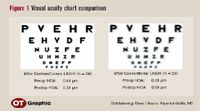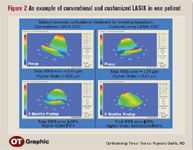Article
Wavefront-guided LASIK appropriate for patients with mixed astigmatism
Margate, FL-Eyes with mixed astigmatism have a range of naturally occurring higher-order aberrations that consist primarily of coma and spherical aberration. Wavefront-guided LASIK may be beneficial over conventional LASIK because of decreased higher-order aberrations overall, according to Raymond Gailitis, MD.

He and his colleagues conducted a prospective center study that took place at 11 sites. He is in private practice in Margate, FL.
The investigators evaluated the baseline wavefront aberrations in the eyes with mixed astigmatism. The patients were re-examined at 3 and 6 months after wavefront-guided LASIK. The data from this cohort were compared with patients who underwent treatment with conventional LASIK.

He demonstrated the preoperative condition in a couple of cases. Interestingly, both eyes had –3.25 D of cylinder; one eye had a myopic defocus and the other a hyperopic defocus, but the astigmatism appeared similar in the two eyes.
The most common baseline higher-order aberrations were coma, trefoil, and spherical aberration, he said.
"Three and 6 months following LASIK we found a statistically significant decrease in total root mean square (RMS) and spherical aberration, but not much change in coma.
"About 50% of the eyes had reduced higher-order aberrations and coma and about 80% had reduced spherical aberration," Dr. Gailitis reported.
When the 110 eyes were compared with 26 eyes that underwent conventional LASIK, the preoperative parameters were similar between the two groups. However, postoperatively there were substantial differences between the wavefront-treated and conventionally treated groups.

"Baseline wavefront aberrations in eyes with mixed astigmatism reflect the predominant error, which is astigmatism. Wavefront cylinder correlates strongly with the cycloplegic cylinder and a range of naturally occurring higher-order aberrations consists primarily of coma and spherical aberrations. At the 3-and 6-month follow-up visits, there was a significant reduction in mean total RMS error and spherical aberration in the eyes treated with the CustomCornea procedure," Dr. Gailitis said.
Newsletter
Don’t miss out—get Ophthalmology Times updates on the latest clinical advancements and expert interviews, straight to your inbox.




